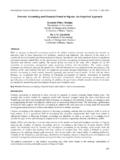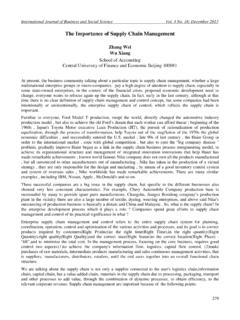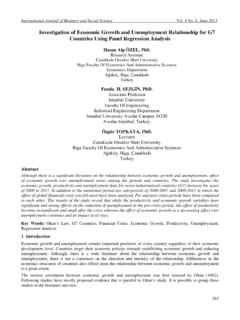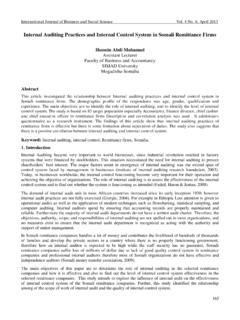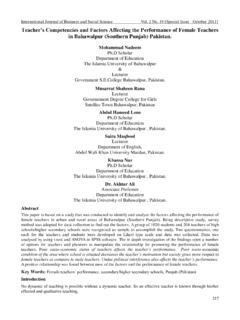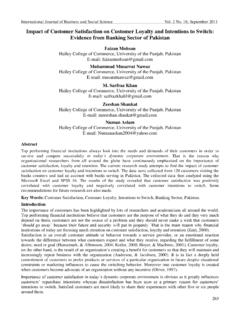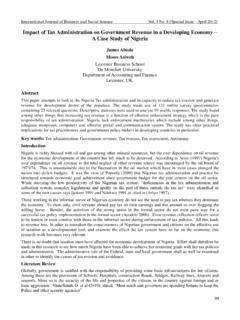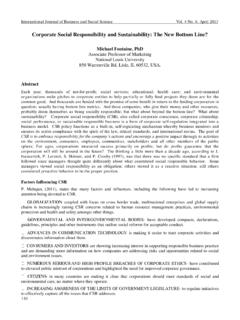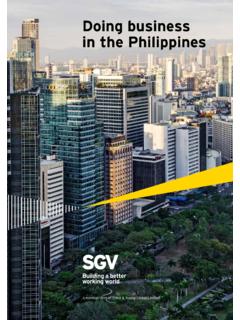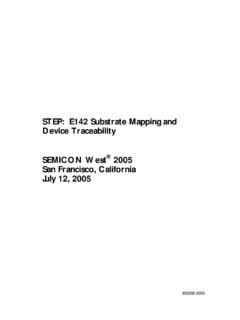Transcription of GLOBAL TRENDS IN OFFSHORING AND OUTSOURCING
1 International Journal of business and Social Science Vol. 2 No. 16; September 2011 13 GLOBAL TRENDS IN OFFSHORING AND OUTSOURCING Nora Palugod, Ph. D. Assistant Professor of business The Richard Stockton College of New Jersey 101 Vera King Farris Drive Galloway, NJ 08205-9441, E-mail: Phone: 609-652-4405 Paul A. Palugod, Executive Vice President Insights business Solutions, LLC 136 Mourning Dove Way, Galloway, NJ 08205, E-mail: Phone: 609-748-1703 ABSTRACT The rapid growth of OFFSHORING and OUTSOURCING has transformed the way businesses are managing their operations in this GLOBAL world. This has brought considerable benefits as well as challenges and often political backlash. In this paper, we analyze the basic facts and TRENDS surrounding the OFFSHORING and OUTSOURCING phenomenon. We attempt to understand the genesis and basic drivers behind OFFSHORING and OUTSOURCING .
2 We examine market TRENDS , the prospects for growth, and the operational models followed in OFFSHORING and OUTSOURCING . We analyze buyer TRENDS and the geographic source of buyers and the location TRENDS for OFFSHORING . Keywords: GLOBAL OUTSOURCING , OFFSHORING , business Process OUTSOURCING , GLOBAL TRENDS in OUTSOURCING , TRENDS in OFFSHORING . INTRODUCTION The use of the terms OUTSOURCING , business process OUTSOURCING (BPO), and OFFSHORING have been used interchangeably and have caused considerable confusion. In the popular press, OUTSOURCING is many times incorrectly referred to as companies employing service providers from other countries. OUTSOURCING refers to the decision of a firm whether to handle the function internally or to have another firm handle the function while OFFSHORING refers to the location of the function. In other words, OUTSOURCING and OFFSHORING refer to different dimensions of a firm s decisions.
3 OUTSOURCING occurs when a company uses another company to undertake some function previously performed internally or in-house. For example, many companies use other companies to handle their payroll functions. One of the pioneer providers of such payroll and finance services is EDS. OUTSOURCING is not a new concept. In fact, OUTSOURCING of manufacturing or production processes is the normal way of producing goods and services. Most companies are not sufficiently vertically integrated to undertake all their business and manufacturing functions. The new phenomenon of OUTSOURCING refers to the recent dramatic growth of OUTSOURCING of services, particularly of IT services and business process services as opposed to the OUTSOURCING of manufacturing processes. OFFSHORING occurs when a company performs a production or service function in another country. The function or process can be performed within the same company (also referred to as a subsidiary, captive or shared service division) or can be performed by another firm.
4 When the process is undertaken by another firm, referred to as a third party, the function or process is both offshored and outsourced. Figure 1 summarizes the distinction between OUTSOURCING and OFFSHORING . GLOBAL OFFSHORING TRENDS OFFSHORING and OUTSOURCING Services The globalization of service OFFSHORING and OUTSOURCING begun to take off in late 1990s. The basic driving force was the growth and technological improvements in information and communication technology (ICT). _____ Sponsor Organizations: The Richard Stockton College of New Jersey Insights business Solutions, LLC Centre for Promoting Ideas, USA 14 In essence, these new technologies in ICT allowed digitization which in turn allowed the separation of service processes. Before the ICT revolution, services had to be done on site in situ. For example, call centers and help desks were mainly based in-house prior to the ICT revolution because communication facilities in other locations were inadequate or expensive to set up or both.
5 Offshored services begun with relatively simple processes such as computer coding, data management, help desk operations, and call centers. They are constantly expanding and evolving. These services are varied and include human resource administration, benefits administration, check processing services, financial reporting and analysis, asset management services, legal services, procurement services. Offshored services are usually categorized under two major classifications, either as an information technology (IT) service or as a business process service. If undertaken by a third party, these services are referred to as information technology OUTSOURCING (ITO) services and business process OUTSOURCING (BPO) ITO includes low-end services such as software coding, testing, and maintenance as well as higher-end services such as systems integration and consulting. OFFSHORING begun with low-end services for IT as a result of the labor shortage for skilled programmers in the United States and other countries.
6 ITO is often classified into three major types, namely, infrastructure services, software services, and IT consulting. Infrastructure services include applications management and network management while software services (often referred to as applications development and maintenance or ADM) include desktop management, application development, application integration, and enterprise resource planning (ERP). BPO is often categorized according to the major business processes involved. These business process include finance and accounting, procurement, logistics, supply chain management, human resource management, and customer relationship management GLOBAL Market TRENDS The GLOBAL OFFSHORING market has grown rapidly from its initial phase of evolution in 1995-2000. The initial offshore market consisted of IT services as a result of the increased demand arising from the increased adoption of computer technologies by businesses.
7 Much of these IT OFFSHORING went to India. In 1999, software exports from India amounted to $4 billion (Evalueserve, 2004). By 2009, GLOBAL ITO has grown to $56 billion (IDC-NASSCOM Strategic Review, 2009). business process OFFSHORING expanded together with the OFFSHORING of IT services. By 2009, BPO has grown to $38 billion from $12 billion in 2004. Figure 3 shows the growth of the GLOBAL OFFSHORING market from 2004 to 2009. As evident from figure 3, the market for OFFSHORING was impacted by the recession of 2008-2009. Particularly affected was the OFFSHORING of finance functions. Despite the recession, the market did not decline on aggregate and is expected to resume its previous growth trend in 2010 and beyond OFFSHORING services has as evolved from mainly IT services towards business process services and from low end to higher value added services and more knowledge based services such as research and analytics.
8 The trend to more business processes is a logical consequence of the fact that the basic enabling technology of business process OFFSHORING is the availability of software and effective infrastructure to handle business process OUTSOURCING . There also appears to be a significant learning by doing involved both on the part of the clients as they transform their processes and on the part of the suppliers as they learn about their capabilities. The initial stage of the evolution of ITO and BPO was mainly to take advantage of cost arbitrage and to take advantage of skills. As clients learn more about their processes and the opportunities for OUTSOURCING they are able to identify processes that can be potentially outsourced and thus are able transform their operating models to further concentrate on core processes. Offshore Source Market TRENDS ITO and BPO will continue to be dominated by clients from developed countries particularly the United States and those in Europe (particularly UK).
9 In 2008, the alone accounted for 60 per cent of Indian IT and BPO exports. In terms of growth rates, the European market has grown significantly at a rate of 41% for the UK and more than 50% for the rest of continental Europe. Thus it is expected that among the developed countries, European countries will increase their adoption of the OUTSOURCING service model. Other emerging markets for OFFSHORING include countries in Asia Pacific (China, and Japan) and countries form Latin America (Brazil, Argentina, Mexico). 1 To emphasize the fact that the major enabling factor of BPO is telecommunication technology, BPO is sometimes referred to as information and communication technology (ICT)-enabled services or ITES information technology enabled services. International Journal of business and Social Science Vol. 2 No. 16; September 2011 15 A closer look at TCS, the leading IT and BPO service provider in India, indicates the dominance of the United States and Europe as a major source of offshore services.
10 As shown in figure 4 the United States, together with UK and the rest of Europe, accounted for 79 per cent of TCS s revenues in 2009. OFFSHORING Buyer TRENDS BPO will continue to be dominated by large buyers. BPO was pioneered by large sized companies particularly those in the GLOBAL 100 then quickly expanded to the GLOBAL 500. This dominance by large buyers is expected to continue. Figure 5 shows that 93% of all multi-process BPO contracts from 1996-2006 were accounted for by companies with annual revenues of at least US1 billion While ITO and BPO will continue to be largely dominated by large players, mid-market buyers are starting to emerge. Figure 6 shows the growth of the mid-market in the BPO space. The cumulative number of contract has risen from 3 contracts in 2000 to 20 contract in 2006. The emergence of mid-market and other smaller clients is attributed to several factors. First, BPO delivery providers have matured sufficiently in scale and experience to accommodate smaller organizations.
